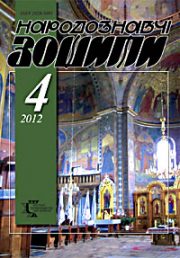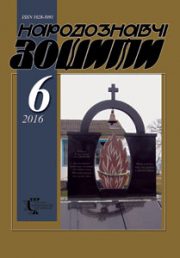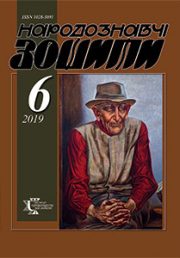The Ethnology Notebooks. 2019, 2 (146), 495—502
DOI https://doi.org/10.15407/nz2019.02.495
NONEXISTING TSERKVAS AS UKRAINIAN CULTURAL HERITAGE IN SACRAL LANDSCAPE IN KRAMPNA COMMUNE
KOZAK Anna
Master’s degree, Assistant
Department of Environmental Protection and Landscape
Lublin Catholic University named after John Paul II
20-708, Lublin, Konstantinov St., 1H,
Contacts: e-mail: hannakozak@kul.lublin.pl
KOZAK Igor
ORCID ID: http://orcid.org/0000-0002-4163-5534
Doctor of Biological Sciences
Professor of the Department of Landscape Ecology
Lublin Catholic University named after John Paul II
20-708, Lublin, Konstantinov St., 1H,
Contacts: e-mail: modeliho@kul.lublin.pl
Abstract. The article presents the nonexisting tserkvas in sacred landscape in Krampna commune (in Poland). These tserkvas represent 13 sacral objects with the architectural specificity of the Ukrainian wooden and stone tserkva. History of nonexisting tserkvas in the landscape of Krampna commune has been analyzed. In particular, there was noted the uniqueness of the Ukrainian tserkva, the technique of “zrub” and elements of “zalom” in its architecture. This aspect integrates Ukrainian tserkvas, which vary only in terms proportions in length, width and height. Tserkvas in Krampna commune were destroyed after the year 1945-1947. Tserkvas lost the religious role and sacred landscape lost its meaning. The article shows the specificity of tserkvas architecture. Nonexisting tserkvas were analyzed in the Krampna commune with their surrounding landscape. It is proved that these all are original and represent a wide diversity of architecture and symbols of Ukrainian religious architecture. The article discusses the perspective of maintaining and reconstructing tserkvas, as well as manner and methods of studying this issue.
Keywords: sacred landscape, Ukrainian tserkva, Krampna commune.
Received 15.02.2019
REFERENCES
Veczerskyj, V. (2008). Ukrainian wooden tserkvas. Kiev: Our time [in Ukrainian].
Dragan, M. (1937). Ukrainian wooden tserkvas. Genesis and development of forms. (Ch. 1, 2). Lviv [in Ukrainian].
Taranushchenko, S. (1976). Monumental wooden architecture of the Left Bank of Ukraine. Kiev [in Ukrainian].
Shcherbakivskyi, V. (1906). Wooden tserkvas in Ukraine and their types. Lviv [in Ukrainian].
Blaїejowsky, D. (1995). Historical Љematism of the Eparchy of Peremysl’. Lviv: Kamenyar.
Ivanusiv, O. (1987). Church in Ruins: The demise of Ukrainian churches in the eparchy of Peremyshl.
Saіadiak, A. (1993). Monuments of Ukrainian culture in Poland. Warszawa [in Polish].
Apokryf Ruski (2010). Retrieved from: http://www.apokryfruski.org/.
Slobodian, V. (1996). Catalog of existing wooden tserkvas of Ukraine and Ukrainian ethnic lands. Bulletin of the Institute «Ukrzakhidproektrestavratsiya», 4, 74—159 [in Ukrainian].
Kozak, H., Stкpieс, A., & Kozak, I. (2012). Three-dimension modeling in reconstruction of old woodem church in Ukraine. Kultura i Historia, 21.
Kubijovych, V. (1983). Ethnic groups of the South-Western Ukraine (Halychyna-Galicia) 1.1.1939. Mǜnchen: Logos.
Hrushevsky, M. (1900). Sources for the history of Ukraine-Rus (Vol. ІІІ). Lviv [in Ukrainian].
Kubiyovych, V. (1993). Population with Ukrainian language in Galicia. Map. In Encyclopedia of Ukrainian Studies. Lviv: NTSh [in Ukrainian].
Misilo, E. (1989). Greek Catholic tserkvas in Poland (1944— 1947). In Warsaw Ukrainian Studies Notes (Pp. 207—220) [in Ukrainian].
Mapire First Military Survey 1763. Retrieved from: http://mapire.eu/en/map/firstsurvey/.







